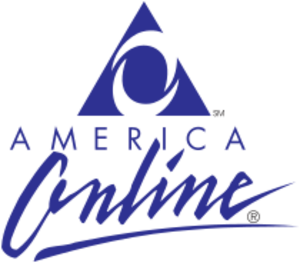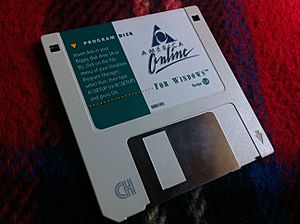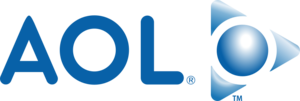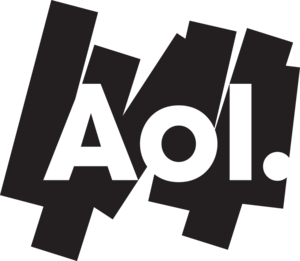AOL facts for kids
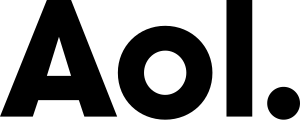 |
|
|
Formerly
|
|
|---|---|
| Subsidiary | |
| Traded as | NYSE: AOL |
| Founded |
|
| Founders |
|
| Headquarters | 770 Broadway,
New York City
,
United States
|
|
Area served
|
Worldwide |
| Services | Web portal and online services |
|
Number of employees
|
5,600 |
| Parent |
|
AOL (stylized as Aol., formerly a company known as AOL Inc. and originally known as America Online) is an American web portal and online service provider based in New York City, and a brand marketed by Yahoo! Inc.
The service traces its history to an online service known as PlayNET. PlayNET licensed its software to Quantum Link (Q-Link), that went online in November 1985. A new IBM PC client was launched in 1988, and eventually renamed as America Online in 1989. AOL grew to become the largest online service, displacing established players like CompuServe and The Source. By 1995, AOL had about three million active users.
AOL was one of the early pioneers of the Internet in the 1990s and was (at one point) the most recognized brand on the web in the United States. AOL once provided a dial-up internet service to millions of Americans and pioneered instant messaging and chat rooms with AOL Instant Messenger (AIM). In 1998, AOL purchased Netscape for US$4.2 billion. By 2000, AOL was providing internet service to over 20 million consumers, dominating the market of internet service providers (ISPs). In 2001, at the height of its popularity, it purchased the media conglomerate Time Warner in the largest merger in US history. AOL rapidly shrank thereafter, partly due to the decline of dial-up and rise of broadband. AOL was eventually spun off from Time Warner in 2009, with Tim Armstrong appointed the new CEO. Under his leadership, the company invested in media brands and advertising technologies.
On June 23, 2015, AOL was acquired by Verizon Communications for $4.4 billion. On May 3, 2021, Verizon announced it would sell Yahoo and AOL to private equity firm Apollo Global Management for $5 billion. On September 1, 2021, AOL became part of the new Yahoo! Inc.
Contents
History
1983–1991: early years
AOL began in 1983, as a short-lived venture called Control Video Corporation (CVC), founded by William von Meister. Its sole product was an online service called GameLine for the Atari 2600 video game console, after von Meister's idea of buying music on demand was rejected by Warner Bros. Subscribers bought a modem from the company for $49.95 and paid a one-time $15 setup fee. GameLine permitted subscribers to temporarily download games and keep track of high scores, at a cost of $1 per game. The telephone disconnected and the downloaded game would remain in GameLine's Master Module and playable until the user turned off the console or downloaded another game.
In January 1983, Steve Case was hired as a marketing consultant for Control Video on the recommendation of his brother, investment banker Dan Case. In May 1983, Jim Kimsey became a manufacturing consultant for Control Video, which was near bankruptcy. Kimsey was brought in by his West Point friend Frank Caufield, an investor in the company. In early 1985, von Meister left the company.
On May 24, 1985, Quantum Computer Services, an online services company, was founded by Kimsey from the remnants of Control Video, with Kimsey as chief executive officer, and Marc Seriff as chief technology officer. The technical team consisted of Seriff, Tom Ralston, Ray Heinrich, Steve Trus, Ken Huntsman, Janet Hunter, Dave Brown, Craig Dykstra, Doug Coward, and Mike Ficco. In 1987, Case was promoted again to executive vice-president. Kimsey soon began to groom Case to take over the role of CEO, which he did when Kimsey retired in 1991.
Kimsey changed the company's strategy, and in 1985, launched a dedicated online service for Commodore 64 and 128 computers, originally called Quantum Link ("Q-Link" for short). The Quantum Link software was based on software licensed from PlayNet, Inc, (founded in 1983 by Howard Goldberg and Dave Panzl). The service was different from other online services as it used the computing power of the Commodore 64 and the Apple II rather than just a "dumb" terminal. It passed tokens back and forth and provided a fixed price service tailored for home users. In May 1988, Quantum and Apple launched AppleLink Personal Edition for Apple II and Macintosh computers. In August 1988, Quantum launched PC Link, a service for IBM-compatible PCs developed in a joint venture with the Tandy Corporation. After the company parted ways with Apple in October 1989, Quantum changed the service's name to America Online. Case promoted and sold AOL as the online service for people unfamiliar with computers, in contrast to CompuServe, which was well established in the technical community.
From the beginning, AOL included online games in its mix of products; many classic and casual games were included in the original PlayNet software system. The company introduced many innovative online interactive titles and games, including:
- Graphical chat environments Habitat (1986–1988) from LucasArts.
- The first online interactive fiction series QuantumLink Serial by Tracy Reed (1988).
- Quantum Space, the first fully automated play-by-mail game (1989–1991).
1991–2006: Internet age, Time Warner merger
In February 1991, AOL for DOS was launched using a GeoWorks interface; it was followed a year later by AOL for Windows. This coincided with growth in pay-based online services, like Prodigy, CompuServe, and GEnie. 1991 also saw the introduction of an original Dungeons & Dragons title called Neverwinter Nights from Stormfront Studios; which was one of the first Multiplayer Online Role Playing Games to depict the adventure with graphics instead of text.
During the early 1990s, the average subscription lasted for about 25 months and accounted for $350 in total revenue. Advertisements invited modem owners to "Try America Online FREE", promising free software and trial membership. AOL discontinued Q-Link and PC Link in late 1994. In September 1993, AOL added Usenet access to its features. This is commonly referred to as the "Eternal September", as Usenet's cycle of new users was previously dominated by smaller numbers of college and university freshmen gaining access in September and taking a few weeks to acclimate. This also coincided with a new "carpet bombing" marketing campaign by CMO Jan Brandt to distribute as many free trial AOL trial disks as possible through nonconventional distribution partners. At one point, 50% of the CDs produced worldwide had an AOL logo. AOL quickly surpassed GEnie, and by the mid-1990s, it passed Prodigy (which for several years allowed AOL advertising) and CompuServe. In November 1994, AOL purchased Booklink for its web browser, to give its users web access. In 1996, AOL replaced Booklink with a browser based on Internet Explorer, allegedly in exchange for inclusion of AOL in Windows.
AOL launched services with the National Education Association, the American Federation of Teachers, National Geographic, the Smithsonian Institution, the Library of Congress, Pearson, Scholastic, ASCD, NSBA, NCTE, Discovery Networks, Turner Education Services (CNN Newsroom), NPR, The Princeton Review, Stanley Kaplan, Barron's, Highlights for Kids, the US Department of Education, and many other education providers. AOL offered the first real-time homework help service (the Teacher Pager—1990; prior to this, AOL provided homework help bulletin boards), the first service by children, for children (Kids Only Online, 1991), the first online service for parents (the Parents Information Network, 1991), the first online courses (1988), the first omnibus service for teachers (the Teachers' Information Network, 1990), the first online exhibit (Library of Congress, 1991), the first parental controls, and many other online education firsts.
AOL purchased search engine WebCrawler in 1995, but sold it to Excite the following year; the deal made Excite the sole search and directory service on AOL. After the deal closed in March 1997, AOL launched its own branded search engine, based on Excite, called NetFind. This was renamed to AOL Search in 1999.
AOL charged its users an hourly fee until December 1996, when the company changed to a flat monthly rate of $19.95. During this time, AOL connections were flooded with users trying to connect, and many canceled their accounts due to constant busy signals. A commercial was made featuring Steve Case telling people AOL was working day and night to fix the problem. Within three years, AOL's user base grew to 10 million people. In 1995, AOL was headquartered at 8619 Westwood Center Drive in the Tysons Corner CDP in unincorporated Fairfax County, Virginia, near the Town of Vienna.
AOL was quickly running out of room in October 1996 for its network at the Fairfax County campus. In mid-1996, AOL moved to 22000 AOL Way in Dulles, unincorporated Loudoun County, Virginia to provide room for future growth. In a five-year landmark agreement with the most popular operating system, AOL was bundled with Windows software.
On March 31, 1996, the short-lived eWorld was purchased by AOL. In 1997, about half of all US homes with Internet access had it through AOL. During this time, AOL's content channels, under Jason Seiken, including News, Sports, and Entertainment, experienced their greatest growth as AOL become the dominant online service internationally with more than 34 million subscribers. In November 1998, AOL announced it would acquire Netscape, best known for their web browser, in a major $4.2 billion deal. The deal closed on March 17, 1999. Another large acquisition in December 1999 was that of MapQuest, for $1.1 billion.
In January 2000, as new broadband technologies were being rolled out around the New York City metropolitan area and elsewhere across the US, AOL and Time Warner announced plans to merge, forming AOL Time Warner, Inc. The terms of the deal called for AOL shareholders to own 55% of the new, combined company. The deal closed on January 11, 2001. The new company was led by executives from AOL, SBI, and Time Warner. Gerald Levin, who had served as CEO of Time Warner, was CEO of the new company. Steve Case served as chairman, J. Michael Kelly (from AOL) was the chief financial officer, Robert W. Pittman (from AOL) and Dick Parsons (from Time Warner) served as co-chief operating officers. In 2002, Jonathan Miller became CEO of AOL. The following year, AOL Time Warner dropped the "AOL" from its name. It was the largest merger in history when completed with the combined value of the companies at $360 billion. This value fell sharply, to as low as $120 billion, as markets repriced AOL's valuation as a pure internet firm more modestly when combined with the traditional media and cable business. This status did not last long, and the company's value rose again within three months. By the end of that year, the tide had turned against "pure" internet companies, with many collapsing under falling stock prices, and even the strongest companies in the field losing up to 75% of their market value. The decline continued though 2001, but even with the losses, AOL was among the internet giants that continued to outperform brick and mortar companies.
In 2004, along with the launch of AOL 9.0 Optimized, AOL also made available the option of personalized greetings which would enable the user to hear his or her name while accessing basic functions and mail alerts, or while logging in or out. In 2005, AOL broadcast the Live 8 concert live over the Internet, and thousands of users downloaded clips of the concert over the following months. In late 2005, AOL released AOL Safety & Security Center, a bundle of McAfee Antivirus, CA anti-spyware, and proprietary firewall and phishing protection software. News reports in late 2005 identified companies such as Yahoo!, Microsoft, and Google as candidates for turning AOL into a joint venture. Those plans were abandoned when it was revealed on December 20, 2005, that Google would purchase a 5% share of AOL for $1 billion.
2006–2009: rebranding and decline
On April 3, 2006, AOL announced that it would retire the full name America Online. The official name of the service became AOL, and the full name of the Time Warner subdivision became AOL LLC. On June 8, 2006, AOL offered a new program called AOL Active Security Monitor, a diagnostic tool to monitor and rate PC security status, and recommended additional security software from AOL or Download.com. Two months later, AOL released AOL Active Virus Shield, a free product developed by Kaspersky Lab, that did not require an AOL account, only an internet email address. The ISP side of AOL UK was bought by Carphone Warehouse in October 2006 to take advantage of its 100,000 LLU customers, making Carphone Warehouse the largest LLU provider in the UK.
In August 2006, AOL announced that it would offer email accounts and software previously available only to its paying customers, provided that users accessed AOL or AOL.com through an access method not owned by AOL (otherwise known as "third party transit", "bring your own access" or "BYOA"). The move was designed to reduce costs associated with the "walled garden" business model by reducing usage of AOL-owned access points and shifting members with high-speed internet access from client-based usage to the more lucrative advertising provider AOL.com. The change from paid to free access was also designed to slow the rate at which members canceled their accounts and defected to Microsoft Hotmail, Yahoo! or other free email providers. The other free services included:
- AIM (AOL Instant Messenger)
- AOL Video, which featured professional content and allowed users to upload videos.
- AOL Local, comprising its CityGuide, Yellow Pages and Local Search services to help users find local information like restaurants, local events, and directory listings.
- AOL News
- AOL My eAddress, a custom domain name for email addresses. These email accounts could be accessed in a manner similar to those of other AOL and AIM email accounts.
- Xdrive, which allowed users to back up files over the Internet. It was acquired by AOL on August 4, 2005, and closed on December 31, 2008. It offered a free 5 GB account (free online file storage) to anyone with an AOL screenname. Xdrive also provided remote backup services and 50 GB of storage for $9.95 per month.
Also in August, AOL informed its US customers of an increase in the price of its dial-up access to $25.90. The increase was part of an effort to migrate the service's remaining dial-up users to broadband, as the increased price was the same as that of its monthly DSL access. However, AOL subsequently began offering unlimited dial-up access for $9.95 a month.
On November 16, 2006, Randy Falco succeeded Jonathan Miller as CEO. In December 2006, AOL closed its last remaining call center in the United States, "taking the America out of America Online," according to industry pundits. Service centers based in India and the Philippines continue to provide customer support and technical assistance to subscribers.
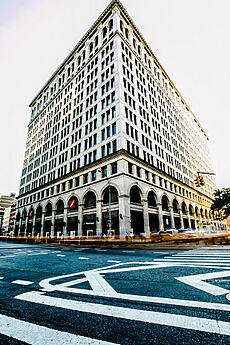
On September 17, 2007, AOL announced the relocation of one of its corporate headquarters from Dulles, Virginia to New York City and the combination of its advertising units into a new subsidiary called Platform A. This action followed several advertising acquisitions, most notably Advertising.com, and highlighted the company's new focus on advertising-driven business models. AOL management stressed that "significant operations" would remain in Dulles, which included the company's access services and modem banks.
In October 2007, AOL announced the relocation of its other headquarters from Loudoun County, Virginia to New York City, while continuing to operate its Virginia offices. As part of the move to New York and the restructuring of responsibilities at the Dulles headquarters complex after the Reston move, Falco announced on October 15, 2007, plans to lay off 2,000 employees worldwide by the end of 2007, beginning "immediately." The result was a layoff of approximately 40% of AOL's employees. Most compensation packages associated with the October 2007 layoffs included a minimum of 120 days of severance pay, 60 of which were offered in lieu of the 60-day advance notice requirement by provisions of the 1988 federal WARN Act.
By November 2007, AOL's customer base had been reduced to 10.1 million subscribers, slightly more than the number of subscribers of Comcast and AT&T Yahoo!. According to Falco, as of December 2007, the conversion rate of accounts from paid access to free access was more than 80%.
On January 3, 2008, AOL announced the closing of its Reston, Virginia data center, which was sold to CRG West. On February 6, Time Warner CEO Jeff Bewkes announced that Time Warner would divide AOL's internet-access and advertising businesses, with the possibility of later selling the internet-access division.
On March 13, 2008, AOL purchased the social networking site Bebo for $850 million (£417 million). On July 25, AOL announced that it was shuttering Xdrive, AOL Pictures and BlueString to save on costs and focus on its core advertising business. AOL Pictures was closed on December 31. On October 31, AOL Hometown (a web-hosting service for the websites of AOL customers) and the AOL Journal blog hosting service were eliminated.
2009–2015: As a digital media company
On March 12, 2009, Tim Armstrong, formerly with Google, was named chairman and CEO of AOL. On May 28, Time Warner announced that it would position AOL as an independent company after Google's shares ceased at the end of the fiscal year. On November 23, AOL unveiled a new brand identity with the wordmark "Aol." superimposed onto canvases created by commissioned artists. The new identity, designed by Wolff Olins, was integrated with all of AOL's services on December 10, the date upon which AOL traded independently for the first time since the Time Warner merger on the New York Stock Exchange under the symbol AOL.
On April 6, 2010, AOL announced plans to shutter or sell Bebo. On June 16, the property was sold to Criterion Capital Partners for an undisclosed amount, believed to be approximately $10 million. In December, AIM eliminated access to AOL chat rooms, noting a marked decline in usage in recent months.
Under Armstrong's leadership, AOL followed a new business direction marked by a series of acquisitions. It announced the acquisition of Patch Media, a network of community-specific news and information sites focused on towns and communities. On September 28, 2010, at the San Francisco TechCrunch Disrupt Conference, AOL signed an agreement to acquire TechCrunch. On December 12, 2010, AOL acquired about.me, a personal profile and identity platform, four days after the platform's public launch.
On January 31, 2011, AOL announced the acquisition of European video distribution network goviral. In March 2011, AOL acquired HuffPost for $315 million. Shortly after the acquisition was announced, Huffington Post co-founder Arianna Huffington replaced AOL content chief David Eun, assuming the role of president and editor-in-chief of the AOL Huffington Post Media Group. On March 10, AOL announced that it would cut approximately 900 workers following the HuffPost acquisition.
On September 14, 2011, AOL formed a strategic ad-selling partnership with two of its largest competitors, Yahoo and Microsoft. The three companies would begin selling inventory on each others' sites. The strategy was designed to help the companies compete with Google and advertising networks.
On February 28, 2012, AOL partnered with PBS to launch MAKERS, a digital documentary series focusing on high-achieving women in industries perceived as male-dominated such as war, comedy, space, business, Hollywood and politics. Subjects for MAKERS episodes have included Oprah Winfrey, Hillary Clinton, Sheryl Sandberg, Martha Stewart, Indra Nooyi, Lena Dunham and Ellen DeGeneres.
On March 15, 2012, AOL announced the acquisition of Hipster, a mobile photo-sharing app, for an undisclosed amount. On April 9, 2012, AOL announced a deal to sell 800 patents to Microsoft for $1.056 billion. The deal included a perpetual license for AOL to use the patents.
In April, AOL took several steps to expand its ability to generate revenue through online video advertising. The company announced that it would offer gross rating point (GRP) guarantee for online video, mirroring the television-ratings system and guaranteeing audience delivery for online-video advertising campaigns bought across its properties. This announcement came just days before the Digital Content NewFront (DCNF) a two-week event held by AOL, Google, Hulu, Microsoft, Vevo and Yahoo to showcase the participating sites' digital video offerings. The DCNF was conducted in advance of the traditional television upfronts in the hope of diverting more advertising money into the digital space. On April 24, the company launched the AOL On network, a single website for its video output.
In February 2013, AOL reported its fourth quarter revenue of $599.5 million, its first growth in quarterly revenue in eight years.
In August 2013, Armstrong announced that Patch Media would scale back or sell hundreds of its local news sites. Not long afterward, layoffs began, with up to 500 out of 1,100 positions initially impacted. On January 15, 2014, Patch Media was spun off, and majority ownership was held by Hale Global. By the end of 2014, AOL controlled 0.74% of the global advertising market, well behind industry leader Google's 31.4%.
On January 23, 2014, AOL acquired Gravity, a software startup that tracked users' online behavior and tailored ads and content based on their interests, for $83 million. The deal, which included approximately 40 Gravity employees and the company's personalization technology, was Armstrong's fourth-largest deal since taking command in 2009. Later that year, AOL acquired Vidible, a company that developed technology to help websites run video content from other publishers, and help video publishers sell their content to these websites. The deal, which was announced December 1, 2014, was reportedly worth roughly $50 million.
On July 16, 2014, AOL earned an Emmy nomination for the AOL original series The Future Starts Here in the News and Documentary category. This came days after AOL earned its first Primetime Emmy Award nomination and win for Park Bench with Steve Buscemi in the Outstanding Short Form Variety Series. Created and hosted by Tiffany Shlain, the series focused on humans' relationship with technology and featured episodes such as "The Future of Our Species," "Why We Love Robots" and "A Case for Optimism."
2015–2021: division of Verizon
On May 12, 2015, Verizon announced plans to buy AOL for $50 per share in a deal valued at $4.4 billion. The transaction was completed on June 23. Armstrong, who continued to lead the firm following regulatory approval, called the deal the logical next step for AOL. "If you look forward five years, you're going to be in a space where there are going to be massive, global-scale networks, and there's no better partner for us to go forward with than Verizon." he said. "It's really not about selling the company today. It's about setting up for the next five to 10 years."
Analyst David Bank said he thought the deal made sense for Verizon. The deal will broaden Verizon's advertising sales platforms and increase its video production ability through websites such as HuffPost, TechCrunch, and Engadget. However, Craig Moffett said it was unlikely the deal would make a big difference to Verizon's bottom line. AOL had about two million dial-up subscribers at the time of the buyout. The announcement caused AOL's stock price to rise 17%, while Verizon's stock price dropped slightly.
Shortly before the Verizon purchase, on April 14, 2015, AOL launched ONE by AOL, a digital marketing programmatic platform that unifies buying channels and audience management platforms to track and optimize campaigns over multiple screens. Later that year, on September 15, AOL expanded the product with ONE by AOL: Creative, which is geared towards creative and media agencies to similarly connect marketing and ad distribution efforts.
On May 8, 2015, AOL reported its first-quarter revenue of $625.1 million, $483.5 million of which came from advertising and related operations, marking a 7% increase from Q1 2014. Over that year, the AOL Platforms division saw a 21% increase in revenue, but a drop in adjusted OIBDA due to increased investments in the company's video and programmatic platforms.
On June 29, 2015, AOL announced a deal with Microsoft to take over the majority of its digital advertising business. Under the pact, as many as 1,200 Microsoft employees involved with the business will be transferred to AOL, and the company will take over the sale of display, video, and mobile ads on various Microsoft platforms in nine countries, including Brazil, Canada, the United States, and the United Kingdom. Additionally, Google Search will be replaced on AOL properties with Bing—which will display advertising sold by Microsoft. Both advertising deals are subject to affiliate marketing revenue sharing.
On July 22, 2015, AOL received two News and Documentary Emmy nominations, one for MAKERS in the Outstanding Historical Programming category, and the other for True Trans With Laura Jane Grace, which documented the story of Laura Jane Grace, a transgender musician best known as the founder, lead singer, songwriter and guitarist of the punk rock band Against Me!, and her decision to come out publicly and overall transition experience.
On September 3, 2015, AOL agreed to buy Millennial Media for $238 million. On October 23, 2015, AOL completed the acquisition.
On October 1, 2015, Go90, a free ad-supported mobile video service aimed at young adult and teen viewers that Verizon owns and AOL oversees and operates launched its content publicly after months of beta testing. The initial launch line-up included content from Comedy Central, HuffPost, Nerdist News, Univision News, Vice, ESPN and MTV.
On April 20, 2016, AOL acquired virtual reality studio RYOT to bring immersive 360 degree video and VR content to HuffPost's global audience across desktop, mobile, and apps.
In July 2016, Verizon Communications announced its intent to purchase the core internet business of Yahoo!. Verizon merged AOL with Yahoo into a new company called "Oath Inc.", which in January 2019 rebranded itself as Verizon Media.
In April 2018, Oath Inc. sold Moviefone to MoviePass Parent Helios and Matheson Analytics.
In November 2020 the Huffington Post was sold to BuzzFeed in a stock deal.
2021–present: Apollo Global Management
On May 3, 2021, Verizon announced it would sell 90 percent of its Verizon Media division to Apollo Global Management for $5 billion. The division became the second incarnation of Yahoo! Inc.
Products and services
Content
As of September 1, 2021, the following media brands became subsidiary of AOL's parent Yahoo Inc.
- Engadget
- Autoblog
- TechCrunch
- Built by Girls
AOL's content contributors consists of over 20,000 bloggers, including politicians, celebrities, academics, and policy experts, who contribute on a wide range of topics making news.
In addition to mobile-optimized web experiences, AOL produces mobile applications for existing AOL properties like Autoblog, Engadget, The Huffington Post, TechCrunch, and products such as Alto, Pip, and Vivv.
Advertising
AOL has a global portfolio of media brands and advertising services across mobile, desktop, and TV. Services include brand integration and sponsorships through its in-house branded content arm, Partner Studio by AOL, as well as data and programmatic offerings through ad technology stack, ONE by AOL.
AOL acquired a number of businesses and technologies help to form ONE by AOL. These acquisitions included AdapTV in 2013 and Convertro, Precision Demand, and Vidible in 2014. ONE by AOL is further broken down into ONE by AOL for Publishers (formerly Vidible, AOL On Network and Be On for Publishers) and ONE by AOL for Advertisers, each of which have several sub-platforms.
On September 10, 2018, AOL's parent company Oath consolidated BrightRoll, One by AOL and Yahoo Gemini to 'simplify' adtech service by launching a single advertising proposition dubbed Oath Ad Platforms, now Yahoo! Ad Tech.
Membership
AOL offers a range of integrated products and properties including communication tools, mobile apps and services and subscription packages.
In 2017, before the discontinuation of AIM, "billions of messages" were sent "daily" on it and AOL's other chat services.
- Dial-up Internet access – While 2.1 million people still used AOL's dial-up service as recently as 2015, only a few thousand were still subscribed as of 2021.
- AOL Mail – AOL Mail is AOL's proprietary email client. It is fully integrated with AIM and links to news headlines on AOL content sites.
- AOL Instant Messenger (AIM) – was AOL's proprietary instant-messaging tool. It was released in 1997. It lost market share to competition in the instant messenger market such as Google Chat, Facebook Messenger, and Skype. It also included a video-chat service, AV by AIM. On December 15, 2017, AOL discontinued AIM.
- AOL Plans – AOL Plans offers three online safety and assistance tools: ID protection, data security and a general online technical assistance service.
AOL Desktop
| Developer(s) | AOL |
|---|---|
| Initial release | December 8, 2007 |
| Stable release |
9.8(Windows)
1.7 (macOS) / August 10, 2015 |
| Preview release |
11.0.3418 / November 11, 2021.
|
| Written in | C++ |
| Operating system | Microsoft Windows XP or later, Mac OS X 10.4.8 or later |
| Type | Internet Suite |
| License | Proprietary |
AOL Desktop is an internet suite produced by AOL from 2007 that integrates a web browser, a media player and an instant messenger client. Version 10.X was based on AOL OpenRide, it is an upgrade from such. The macOS version is based on WebKit.
AOL Desktop version 10.X was different from previous AOL browsers and AOL Desktop versions. Its features are focused on web browsing as well as email. For instance, one does not have to sign into AOL in order to use it as a regular browser. In addition, non-AOL email accounts can be accessed through it. Primary buttons include "MAIL", "IM", and several shortcuts to various web pages. The first two require users to sign in, but the shortcuts to web pages can be used without authentication. AOL Desktop version 10.X was late marked as unsupported in favor of supporting the AOL Desktop 9.X versions.
Version 9.8 was released, replacing the Internet Explorer components of the internet browser with CEF (Chromium Embedded Framework) to give users an improved web browsing experience closer to that of Chrome.
Version 11 of AOL Desktop, was a total rewrite but maintained a similar user interface to the previous 9.8.X series of releases.
In 2017, a new paid version called AOL Desktop Gold was released, available for $4.99 per month after trial. It replaced the previous free version. After the shutdown of AIM in 2017, AOL's original chat rooms continued to be accessible through AOL Desktop Gold, and some rooms remained active during peak hours. That chat system was shut down on December 15, 2020.
In addition to AOL Desktop, the company also offered a browser toolbar Mozilla plug-in, AOL Toolbar, for several web browsers that provided quick access to AOL services. The toolbar was available from 2007 until 2018.
See also
 In Spanish: AOL para niños
In Spanish: AOL para niños
- Adrian Lamo – Inside-AOL.com
- AOHell
- Comparison of webmail providers
- David Shing
- Dot-com bubble
- List of acquisitions by AOL
- List of S&P 400 companies
- Live365
- Truveo


